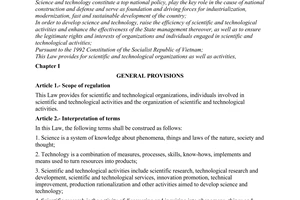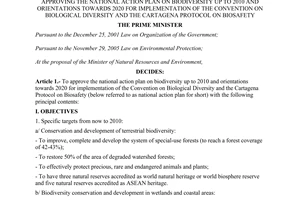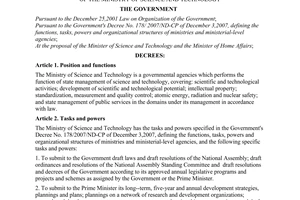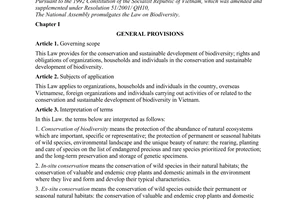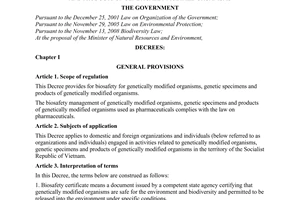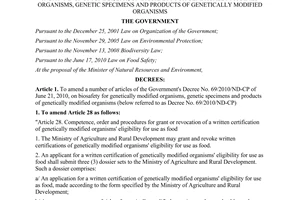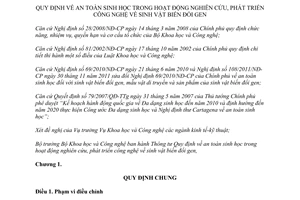Nội dung toàn văn Circular 21/2012/TT-BKHCN biosafety research developing technology related genetically organisms
|
MINISTRY OF
SCIENCE AND TECHNOLOGY |
THE SOCIALIST
REPUBLIC OF VIETNAM |
|
No. 21/2012/TT-BKHCN |
Hanoi, November 20, 2012 |
CIRCULAR
ON BIOSAFETY IN CONDUCTING RESEARCH AND DEVELOPING TECHNOLOGY RELATED TO GENETICALLY MODIFIED ORGANISMS;
Pursuant to the Government’s Decree No. 28/2008/ND-CP dated March 14, 2008 on defining the functions, tasks, powers and organizational structure of the Ministry of Science and Technology ;
Pursuant to the Government’s Decree No. 81/2002/ND-CP dated October 17, 2002 on detailing the implementation of a number of articles of the Ministry of Science and Technology Law;
Pursuant to Decree No. 69/2010/ND-CP dated on June 21, 2010 and Decree No. 108/2011/ND-CP on amendments to the Government’s Decree No. 69/2010/ND-CP dated November 30, 2011 on biosafety for genetically modified organisms, genetic specimens and products of genetically modified organisms;
Pursuant to the Prime Minister’s Decision No.79/2007/QD-TTg dated May 31, 2007 approving the national action plan on biodiversity up to 2010 and orientations towards 2020 for implementation of the convention on biodiversity and the Cartagena Protocol on biosafety;
Considering the suggestions of General Directors of Department of Science and Technology for Economic and Technical branches.
The Minister of Science and Technology promulgates the Circular on biosafety in conducting research and developing technology related to GMOs;
Chapter 1.
GENERAL PROVISIONS
Article 1. Scope
This Circular prescribes the management of biosafety in conducting research and developing technology related to genetically modified organisms, genetic specimens and products of genetically modified organisms (hereafter referred to as GMO research).
Article 2. Regulated entities
This Circular applies to domestic and foreign organizations and individuals (hereafter referred to as organizations and individuals) that are involved in management and research activities related to GMOs, genetic specimens and GMO products in the territory of the Socialist Republic of Vietnam.
Article 3. Definitions
For the purpose of this Circular, the terms below shall be construed as follows:
1. GMO research means activities of researching science and developing technology related to creation, analysis, isolating test of GMOs, genetic specimens and GMO products; analyzing the impacts of GMO products to health of human and domestic animals, biodiversity and environment.
2. Risks mean factors that harm directly or indirectly environment, biodiversity, health of human, plants and domestic animals, may be discovered easily or latent and are results of activities related to GMO research.
3. Biosafety management means measures that ensure safety with regard to environment, biodiversity, health of human, plants and domestic animals.
Article 4. Rules of biosafety management in GMOs research
1. Every GMO research shall comply with the applicable regulations on management of science and technology missions prescribed in Articles 19 and 20 of Science and Technology Law; Article 87 of Law on Environmental Protection; Article 7 of Law on Biodiversity; Articles 44 and 50 of Law on Food Safety and other relevant regulations of law.
2. GMO research that shall be carried out within the scope of science and technology missions (related to subject and project) that are approved by competent authority: National science and technology missions are subject to approval by Ministry of Science and Technology; science and technology missions of ministries and provinces are subject to approval by ministries and People’s Committee of provinces and central-affiliated cities (hereinafter referred to as “provinces”); science and technology missions at grassroots level are subject to by the supervisory organization.
3. GMO research shall only be carried out in the laboratory that has been issued with/granted Certificate of eligibility to conduct GMO research according to its biosafety level.
a) A biosafety level 1 laboratory may: conduct research into gene transfer; analyze and discover GMOs, genetic specimens and GMO products; evaluate and assess quality standards and risks of subjects that do not or hardly affect to the environment, biodiversity, health of human and domestic animals.
b) A biosafety level 2 laboratory may conduct research activities prescribed in Point a of this Clause and conduct research into gene transfer on subjects that pose risk to the environment and biodiversity.
c) A biosafety level 3 laboratory may conduct research activities prescribed in Points a and b of this Clause and research into gene transfer of subjects that pose risk to the environment, biodiversity, health of human and domestic animals;
d) A biosafety level 4 laboratory may conduct research activities prescribed in Points a, b and c of this Clause and research into gene transfer of subjects that pose high risk and are dangerous for human and capable of causing an epidemic.
4. Science and technology missions related to GMOs at ministry, province and grassroots levels of which the giving and receiving subjects that pose high risk to environment, biodiversity and health of human and domestic animals at biosafety level 3 and 4 are subject to written consent of the Ministry of Science and Technology before being approved.
5. Description of science and technology missions related to GMOs shall not only comply with applicable regulations but also have the content of biosafety management: risk analysis and risk management plan.
6. GMO research shall be supervised by Ministry of Science and Technology and other relevant Ministries and Branches.
Chapter 2.
REGULATIONS OF BIOSAFETY MANAGEMENT IN CONDUCTING RESEARCH AND DEVELOPING TECHNOLOGY RELATED TO GMOS
Article 5. Regulations on subgroups of biosafety levels according to risk level of GMOs and their products
1. Biosafety level 1 is associated with GMOs and their products that pose no risk or low risk to environment, biodiversity, health of human, plants and domestic animals.
2. Biosafety level 2 is associated with GMOs and their products that pose moderate risk to environment, biodiversity, health of human, plants and domestic animals.
3. Biosafety level 3 is associated with GMOs and their products that that pose high risk to environment, biodiversity, health of human, plants and domestic animals but the risk is manageable.
4. Biosafety level 4 is associated with GMOs and their products that pose high risk to environment and biodiversity and endanger health of human, plants and domestic animals and there has been no effective measures for management of the risk.
Article 6. Risk analysis and risk management related to GMO research
1. Risk analysis shall be carried out during every stage of the GMO research process if hardly controllable risk is found during a stage, the next stage of the research shall not be carried out.
2. Risk analysis includes: identify risks, analyze and evaluate the levels of risks to biodiversity, environment, health of human and domestic animals according to biosafety risk groups.
3. Determination of risks according to their levels (probable, highly probable, certain) belongs to subject groups as follows:
Risks to soil, water and air environments: Level of pollution and of regression;
b) Risks to biodiversity: negative changes in the species composition;
c) Risk to health of human and domestic animals: toxins, allergens.
4. Risks that are highly probable or certain shall be evaluated in terms of:
a) risks to human health and environment;
b) potential harmful effects of the risk;
c) risks arising from harmful effects;
d) Proposal of practical measures to manage risks
dd) Anticipated overall effects on environment, including positive effects on the environment and human’s health.
5. According to the results of risk analysis, the leader of science and technology mission shall formulate a risk management plan including: solutions for diminishing risks, plan for supervising and evaluating the implementation of the risk management plan.
Solution for diminishing risks is set up according to “prevention is better than cure” principle;
b) The supervision and evaluation plan shall be set up in accordance with contents and research progress.
c) There has to be a plan for prevention of and response to biosafety accidents in the laboratory.
6. Reports on risk analysis and management measures shall be prepared according to forms prescribed in Appendix 1 issued together with this Circular.
Article 7. Biosafety regulations on researching into creation of GMOs
1. General provisions
Research into creation of GMOs shall be only carried out in a laboratory that has been granted the Certificate of GMO biosafety level 1, 2, 3, or 4 laboratory;
b) Research into creation of GMOs shall comply with applicable regulations on safety and hygiene of laboratories.
c) Adequate specimens, raw materials and experimental equipment shall be prepared. Materials, experiment specimens, test tubes and specialized equipment using for studying genetically modified organisms shall have labels showing name and date of implementation.
d) Research into recombinant vector and gene transfer shall be only carried out in the laboratory of the work area having biosafety level 1 or over;
dd) Only transfer gene to 01 subject in one experiment.
e) The person who carries out gene transfer shall wear the lab coat, face mask and gloves. When a person carries out gene transfer, he/she shall sit in front of the biosafety cabinet which is operating, take an adequate amount of materials and avoid dropping.
g) Biosafety cabinets and experiment equipment shall be cleaned with 70% alcohol. Dropped specimens, redundant materials, used cotton wool, used experiment equipment, used test tubes and other used equipment shall be collected, classified and treated before being discharged into the environment. ;
h) Laboratories and biosafety cabinets shall be sterilized with chloramines or 70% alcohol or other permissible antiseptics accordance with regulations.
Experiment products shall be preserved and managed in accordance with law and shall not be brought out of the laboratory without manager’s permission. Any loss of specimens or ransacking shall be reported immediately to the manager for timely solutions to limit uncontrolled spread into environment.
k) If unregulated risks are discovered in the progress, the research shall be immediately stopped and unregulated risks shall be dealt with/handled in accordance with instruction prescribed in Article 12 of this Circular.
2. Biosafety regulations applying to some special research:
Apart from provisions of Clause 1 of this Article, the following provisions shall apply to special research:
Cloning activities on plants: When being cloned, the subject of gene transfer shall be isolated absolutely from other entities. Damaged or unused specimens shall be destroyed in accordance with regulations
Cloning activities on microorganism: test tubes of biomass clone shall be managed strictly. Failed test tubes shall be destroyed in accordance with regulations
Cloning of animals: the quantity of cells that have undergone gene transfer shall be managed strictly before being cultured into the owner. Specimens that are damaged or no longer needed shall be destroyed in accordance with regulations.
Article 8. Biosafety regulations applying to GMO laboratories that are used for research into GMO’s biological characteristics
1. d) Research into GMO’s biological characteristics that are carried out in the laboratory of the work area shall comply with regulations prescribed in Clause 1 Article 7 of this Circular.
2. Research into biological characteristics of genetically modified plants shall comply with regulations below:
Research into GMO’s biological characteristics shall be only carried out in greenhouses or net houses. Research subjects shall be isolated from each other.
b) Equipment that is used for taking care of and cutting plants is only used for a type of genetically modified plant;
c) It is required to wear special shoes when entering greenhouses and net houses;
d) Soil and specimens of GM plants shall not be brought out of greenhouses and net houses without permission;
dd) When taking specimens to analyze, people shall avoid dropping and mixing specimens and manage safety when analyzing specimens.
e) When the experiment finishes, plants that have undergone gene transfer shall be managed strictly regardless of their eligibility to be used as breeds. If they are no longer needed, they shall be destroyed in accordance with regulations.
3. Research into biological characteristics of GM animals which shall be carried out in the auxiliary area:
Cages of subjects that have undergone gene transfer shall be isolated from external environment and have a separate system for collecting wastes and wastewater. Waste and wastewater shall be collected and treated by antidotal chemicals and shall not be discharged into the common sewage system. The solid waste shall be burnt in hermetic ovens;
b) Animals that have undergone gene transferred shall be managed by marking and counting. Animals that are dead or cannot be used as breeds and specimens of genetically modified animals shall be burnt in hermetic ovens.
4. While research into GMO biological characteristics are conducted, if there is any risk with regard to environment, biodiversity, health of human and domestic animals, the supervisory authority of this mission shall inform the competent authority and get opinion about prevention measures.
Article 9. Biosafety regulations on discovery and quality analysis related to GMOs and their products
1. Discovery and quality analysis related to GMOs and their product shall only be carried out in the GMO laboratory whose Certificate was granted.
2. Biosafety management tasks shall comply with regulations in Articles 8, 9 and 10 of this Circular.
Article 10. Application for science and technology mission related to GMO
1. An application for science and technology mission related to GMO shall comply with effective regulations on the application for science and technology mission. The description shall specify adequate information about biological characteristics, results of science and technology research and other issues related to biosafety with regard to GMO. The sections of approach, research method and applied techniques shall contain the risk analysis and risk management plan in accordance with Article 6 of this Circular.
2. Documents about commissioning of a science and technology mission related to GMO shall comply with applicable regulations. The summary report on mission shall have adequate content as prescribed and specify the risks that occurred and measures for risk management that were implemented.
Article 11. The biosafety regulations applied to employees of a GMO laboratory
1. Comply with By-Laws of the laboratory.
2. Do not store food and drink in the GMO laboratory’s fridge.
3. Do not eat and drink in the GMO laboratory.
4. Do not use mouth pipetting when conducting GMO research.
Article 12. Management regulations in case of biosafety accident in a GMO laboratory
1. In case of a biosafety accident, the mission leader and the manager of the GMO laboratory shall:
a) Report the accident immediately to the supervisory authority and indentify areas at risk of accident in the GMO laboratory;
b) Collect specimens that are dropped as much as possible in case of damage to the specimen-containing tubes, infestation of insects or mice into GMO laboratory, spread of specimens because of damaged equipment or breakdown of the GMO laboratory. After specimens are collected, the damaged equipment and GMO laboratory shall be repaired, cleaned and sterilized.
2. If the biosafety accident exceeds the capacity to control of the organization owning the GMO laboratory, this organization shall report immediately in writing to the competent authorities to receive assistance in site supervision and response.
3. After the accident is handled, biosafety 3 and biosafety 4 science and technology missions shall not be continued without the written agreement of the competent authority.
Chapter 3.
MANAGEMENT RESPONSIBILITY AND ACTION AGANST VIOLATION
Article 13. Responsibility for biosafety management in GMO research
1. The responsibility of Ministry of Science and Technology shall:
a) Take responsibility for biosafety management in GMO research in accordance with regulations of this Circular.
b) Take responsibility for approving and managing national science and technology mission related to GMO.
c) Within 30 days from the day on which the application form prescribed in Clause 4 Article 4 of this Circular is received (including the description of mission that was amended after having the analysis, inspection and the Official Dispatch sent by the ministry, the People’s Committee of the province or the science and technology organization (using form in Appendix II issued together with this Circular), the respond in writing whether the mission is permitted (including explanation if the mission is not permitted). The response of the Ministry of Science and Technology is the basis for Ministries, local governments and science and technology organizations to approve science and technology missions.
2. Ministries People’s Committee of provinces shall:
Take responsibility for biosafety management of approved science and technology missions related to GMOs at ministry, province and grassroots levels accordance with regulations of this Circular.
b) Cooperate with Ministry of Science and Technology in inspecting and supervising compliance with regulations on biosafety in GMO research under their management.
c) Submit annual reports to Ministry of Science and Technology on process of science and technology mission related to GMOs under their management (using form in Appendix III issued together with this Circular).
3. Science and technology organizations, GMO laboratories, people conducting GMO research shall:
a) Take responsibility for biosafety management when implementing science and technology missions; science and technology mission;
b) Organize science and technology missions related to GMOs that have been approved in accordance with regulations;
c) Take responsibility for analyzing risks in GMO research and report to Ministry of Science and Technology (with regard to mission approved by Ministry of Science and Technology) or the supervisory ministry or the People’s Committee (with regard to missions approved by ministries and provincial governments). If there is any adjustment to contents of GMO research, the mission shall not continue without written consent of the competent authority.
Article 14. Action against violations
1. Competent authorities that approved science and technology missions related to GMOs prescribed in Clause 2 Article 4 of this Circular may stop or suspend GMO research if there is violation related to biosafety activities or serious risk to health of human, domestic animals, biodiversity and environment.
2. Organizations and individuals that violate the regulations of this Circular or other regulations of law shall have their Certificate of GMO laboratory revoked, face administrative penalties or criminal prosecution in accordance with the Vietnam Law.
Chapter 4.
IMPLEMENTATION CLAUSE
Article 15. Effect
This Circular shall take effects after 45 days from the days on which it is signed.
Article 16. Transition clause
Laboratories which are conducting GMO before this Circular is promulgated shall fulfill the requirements of this Circular by January 01, 2014.
Article 17. Implementation organization
1. Department of Science and Technology for Economic- Technical Branches shall support Ministry of Science and Technology to instruct and manage the implementation of this Circular.
2. Ministries, Branches, People’s Committee of province and central-affiliated cities shall manage and instruct science and technology organizations to implement the regulations on biosafety management within the management scope in accordance with this Circular.
3. During process of implementation, if there is any query or suggestion on contents of this Circular that needs to be adjusted, these written queries and suggestions should be sent to Ministry of Science and Technology.
|
|
P.P. MINISTER |
------------------------------------------------------------------------------------------------------
This translation is made by LawSoft and
for reference purposes only. Its copyright is owned by LawSoft
and protected under Clause 2, Article 14 of the Law on Intellectual Property.Your comments are always welcomed
